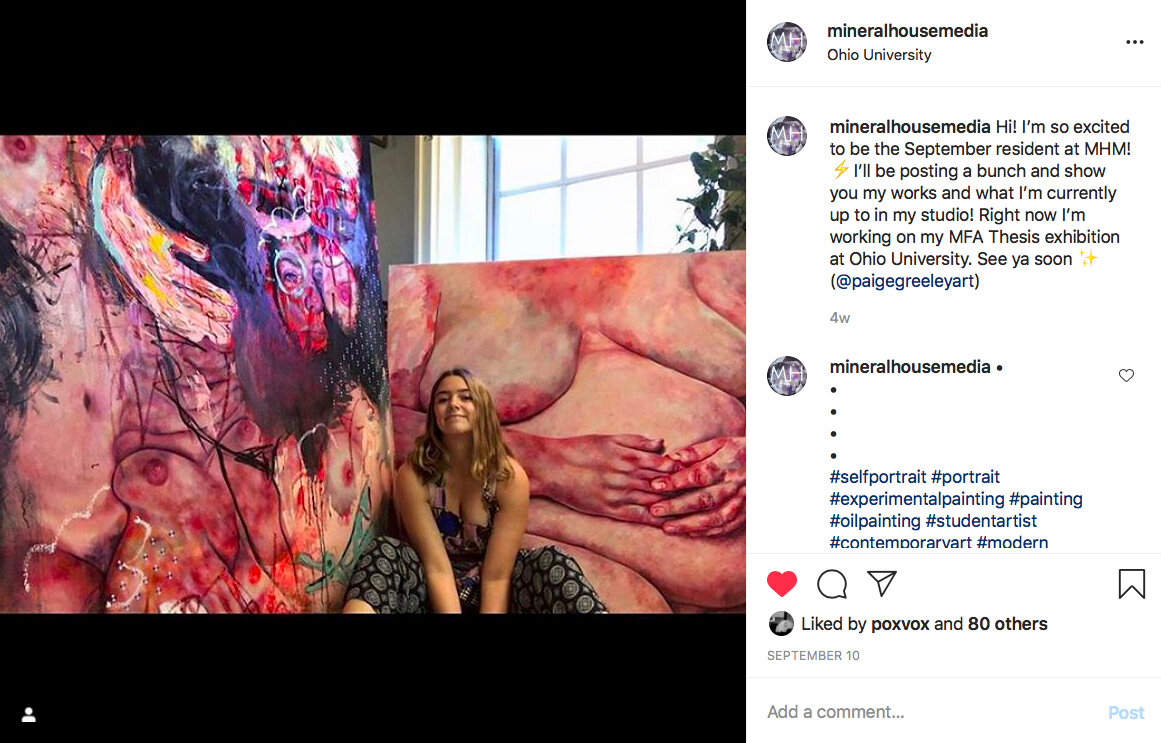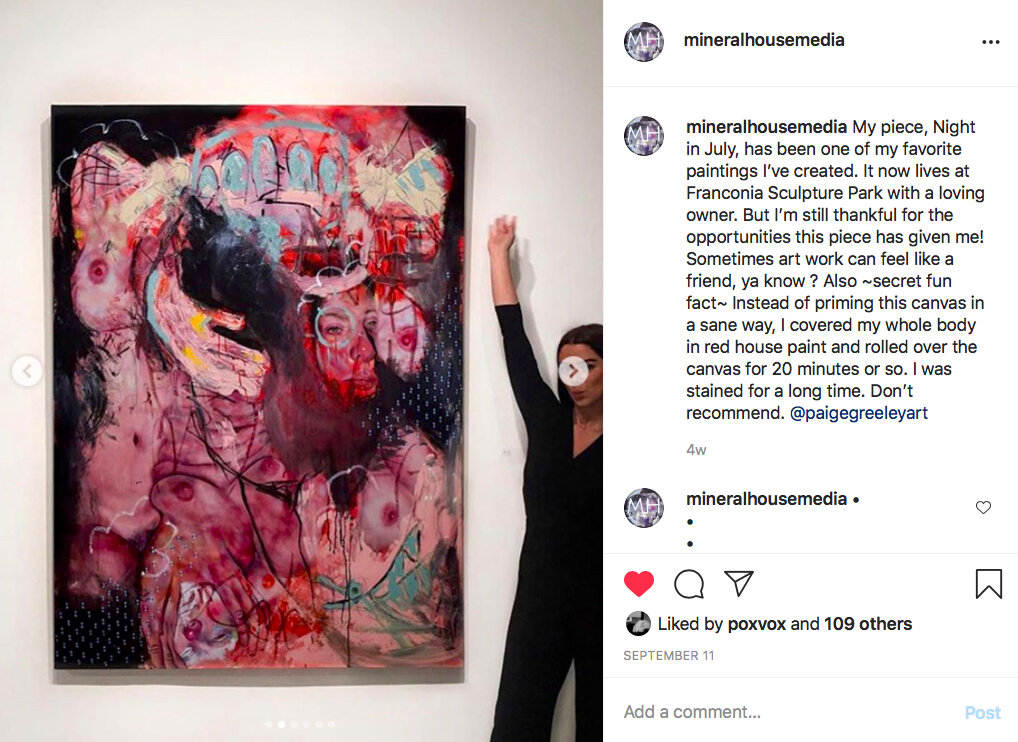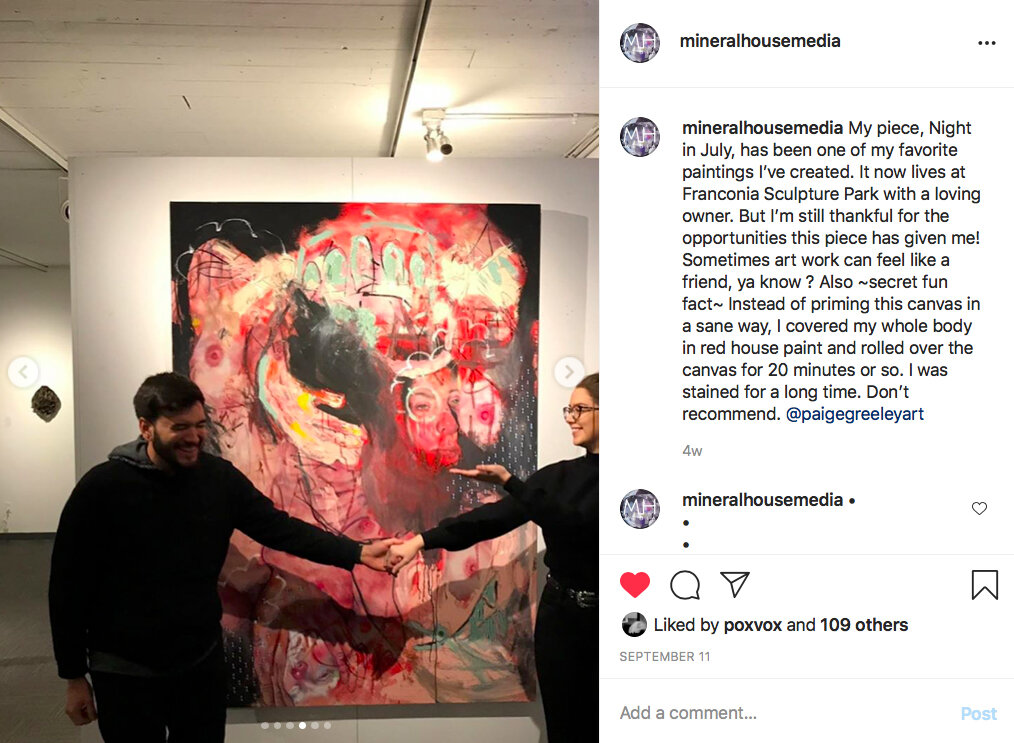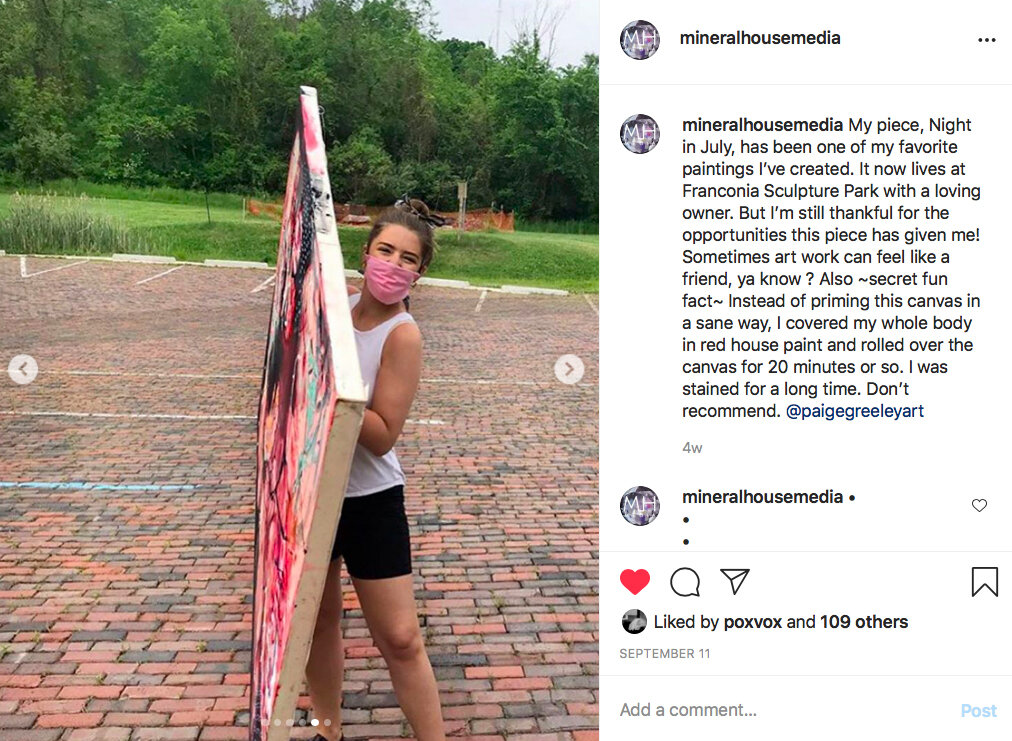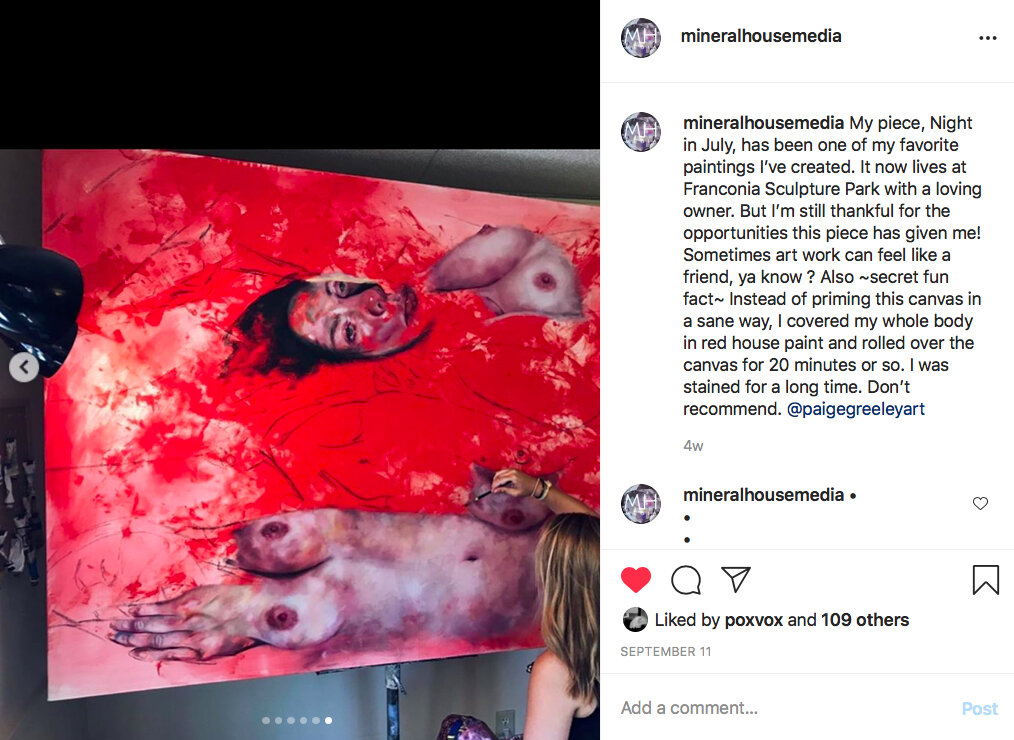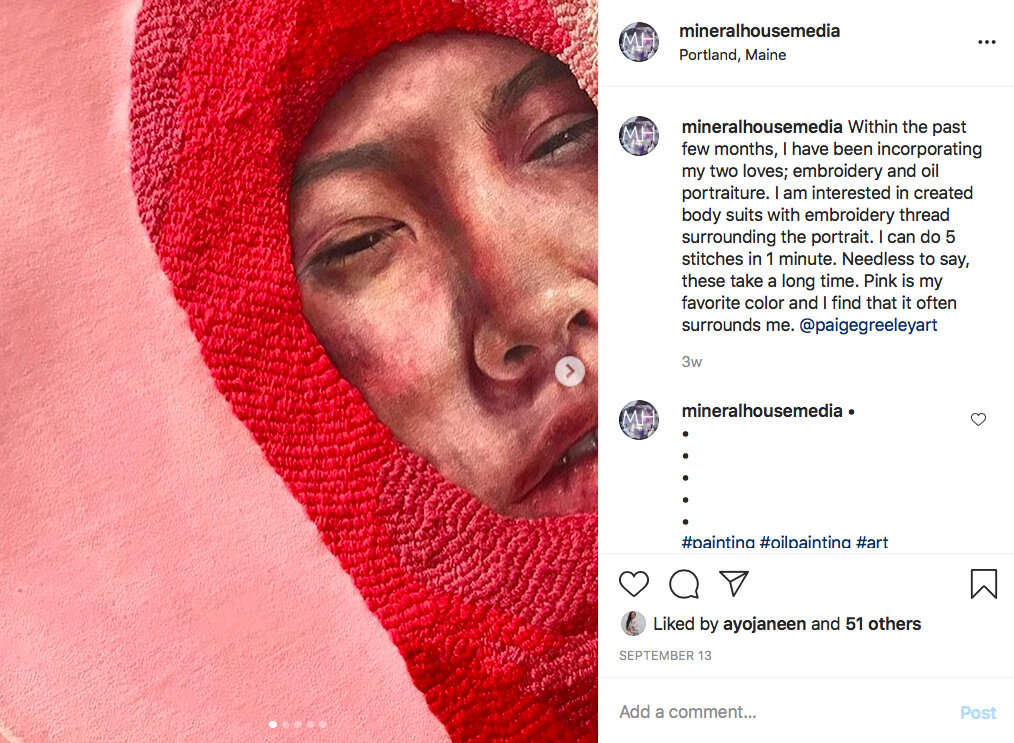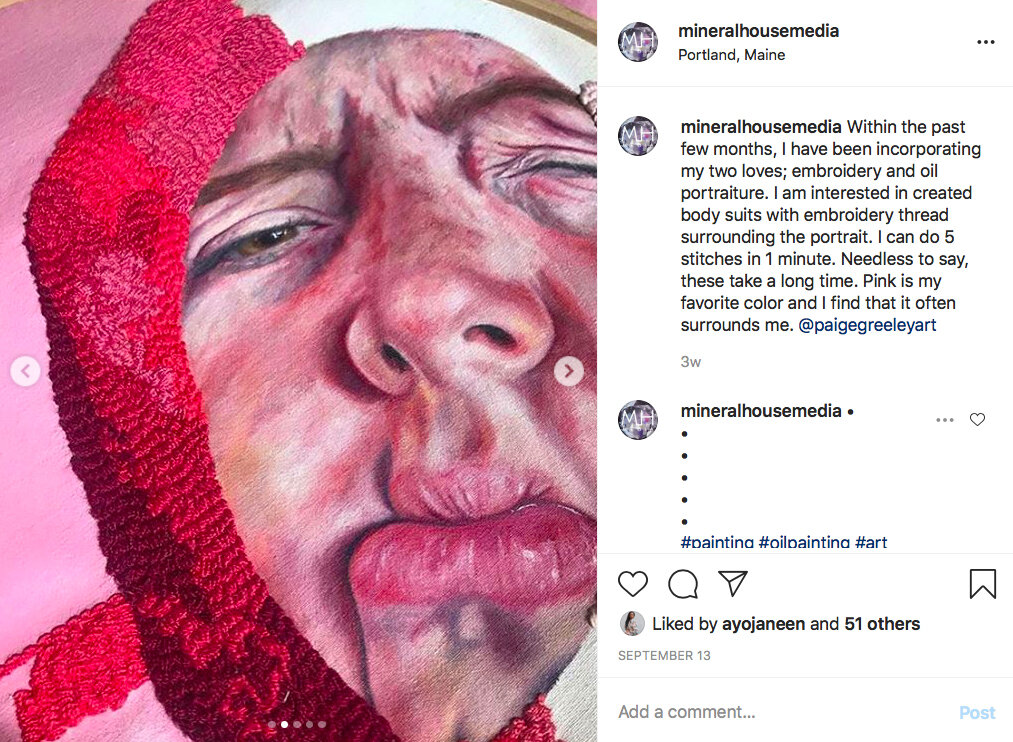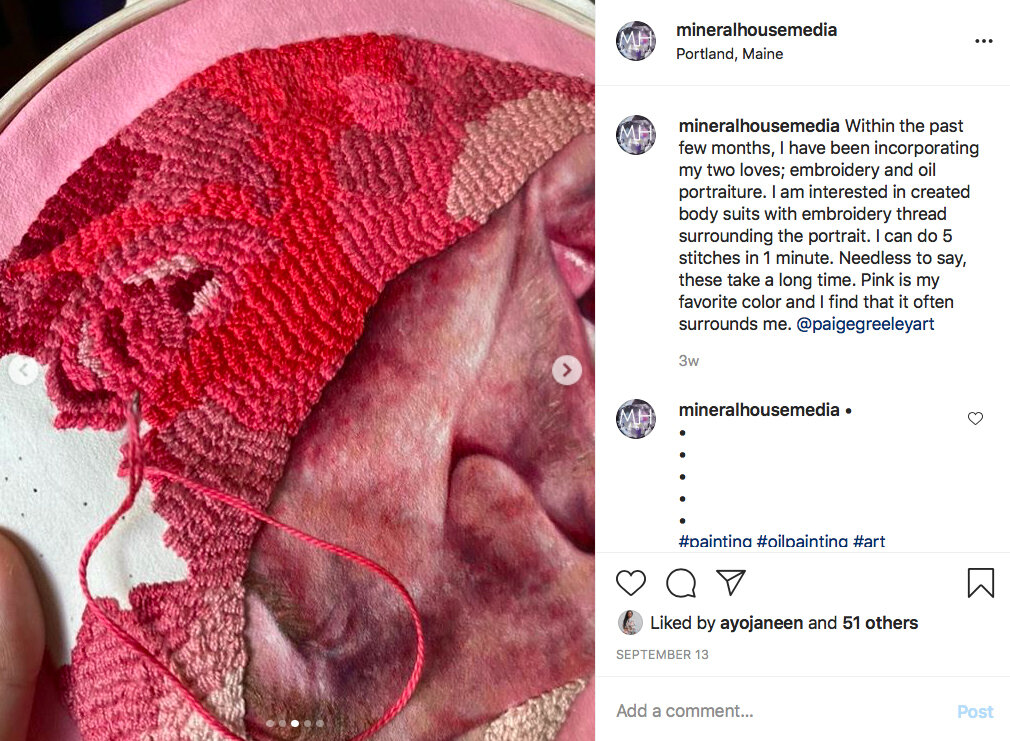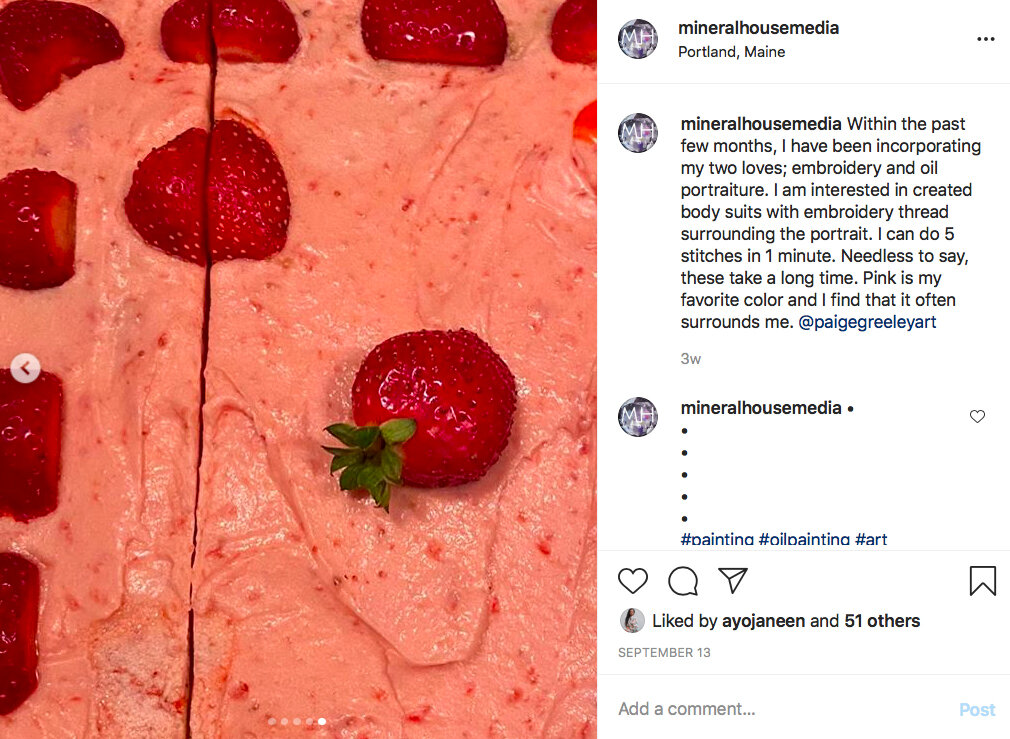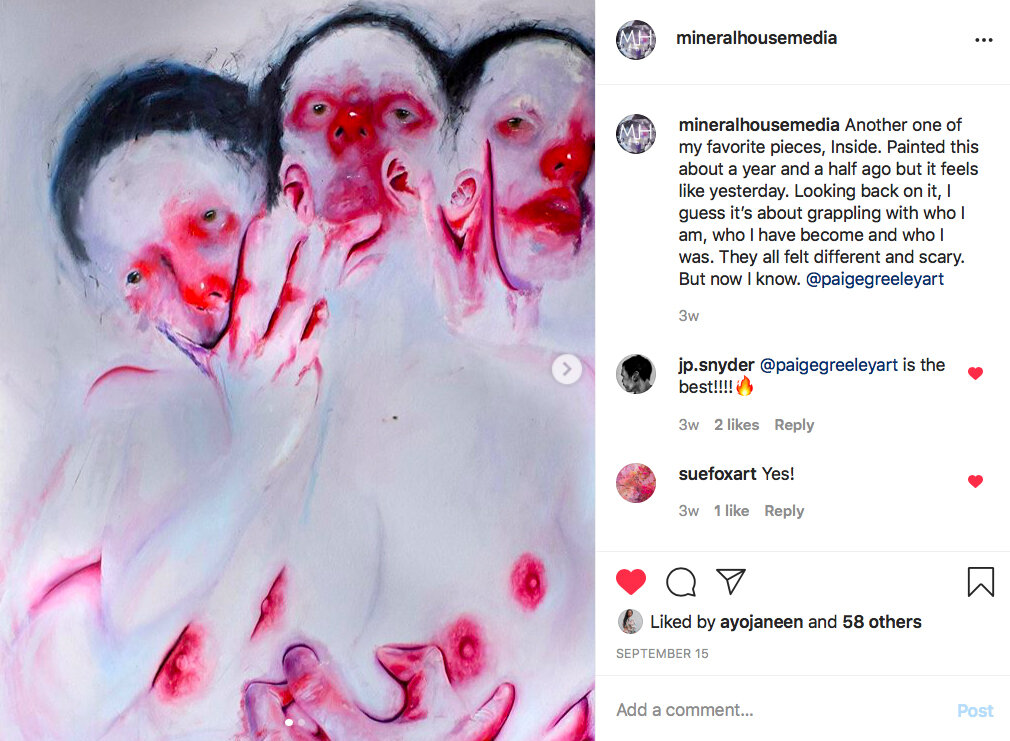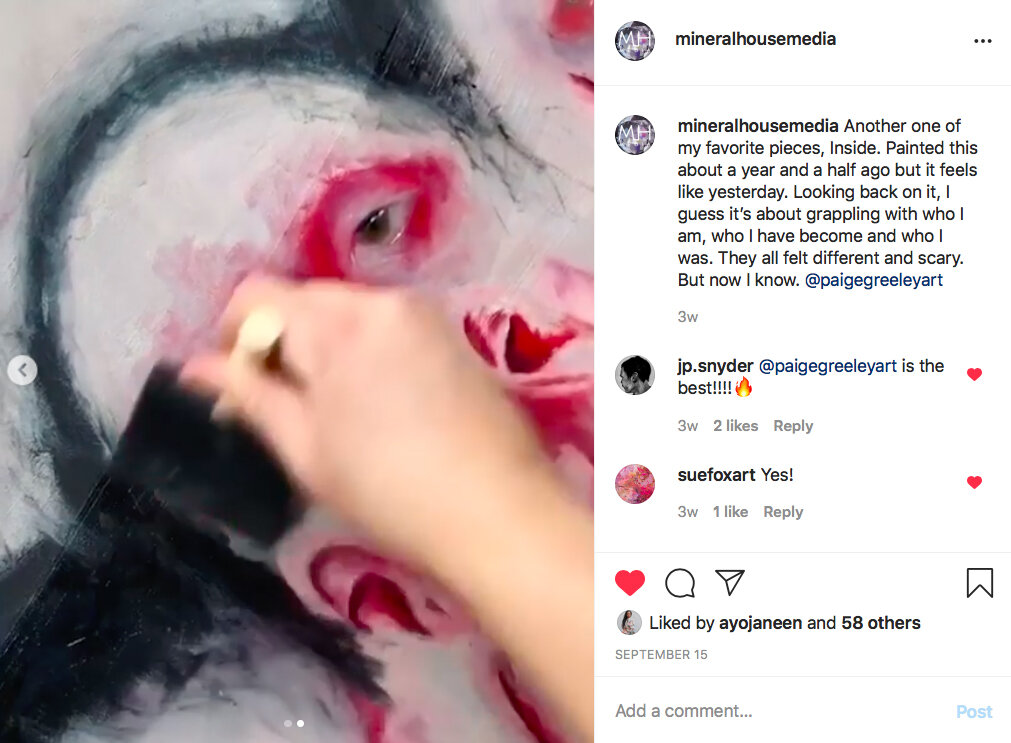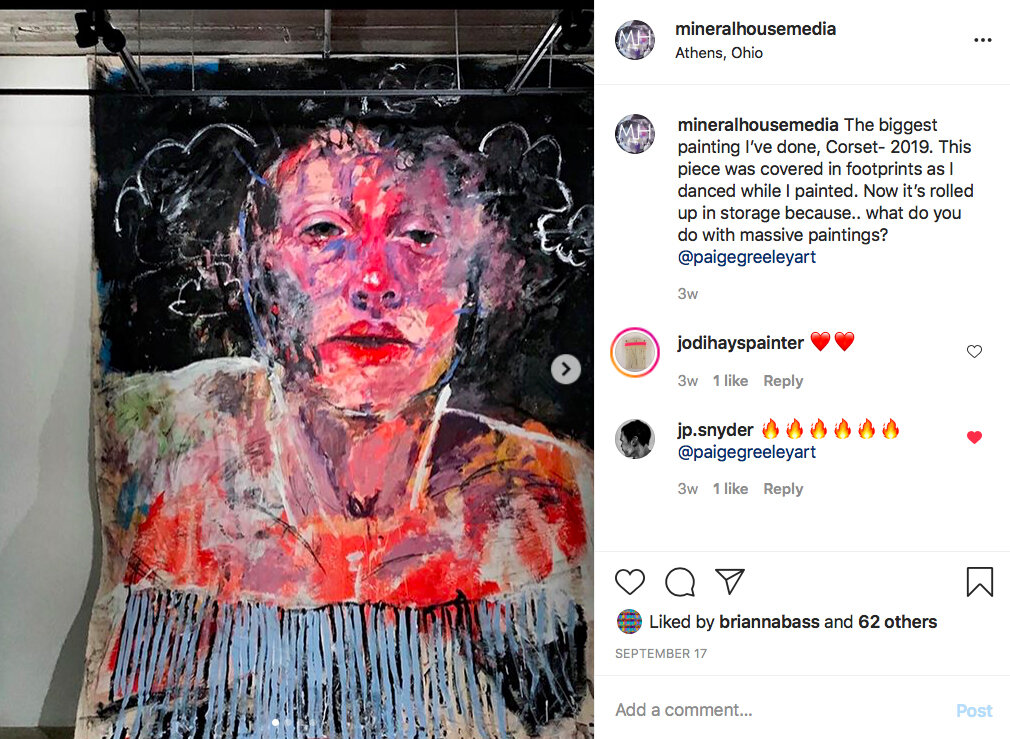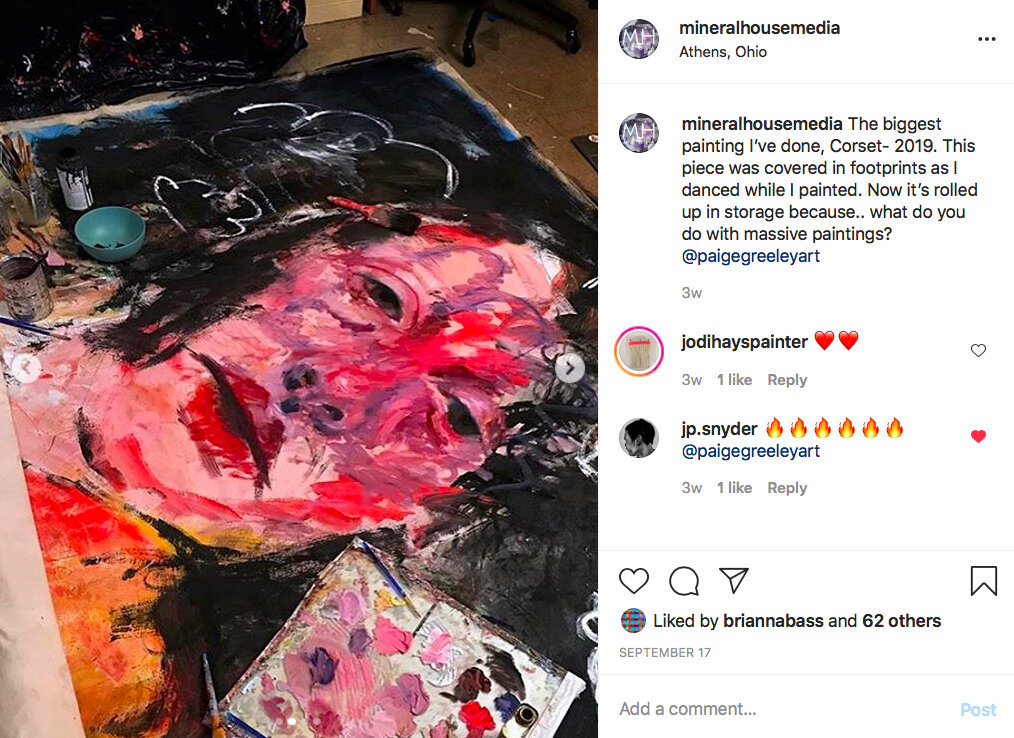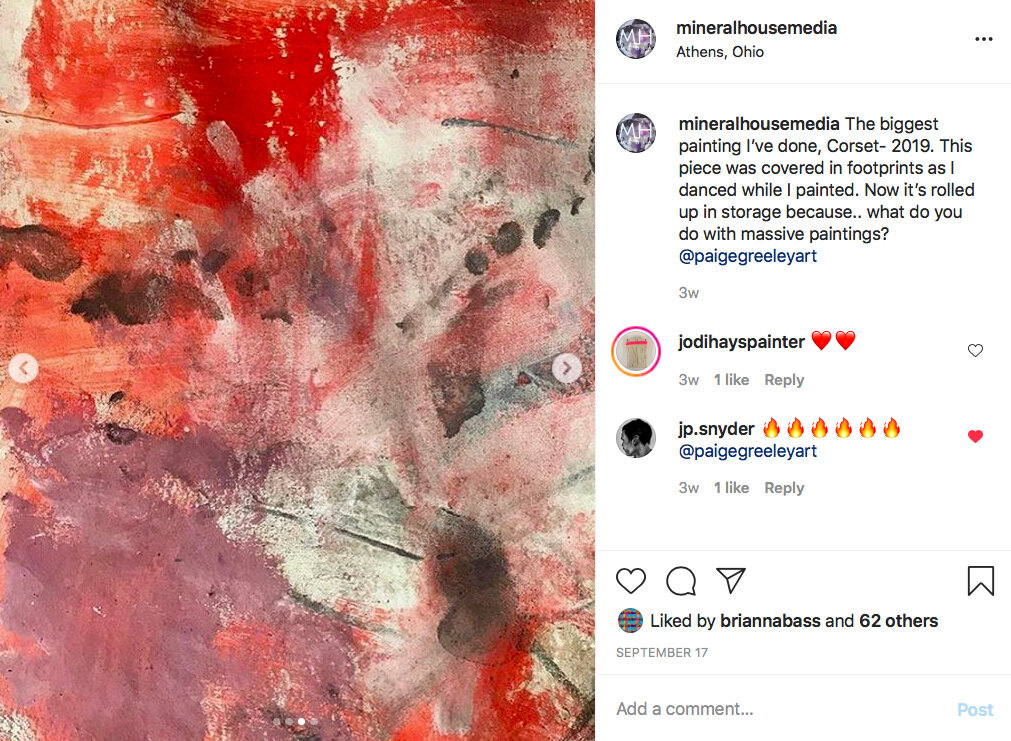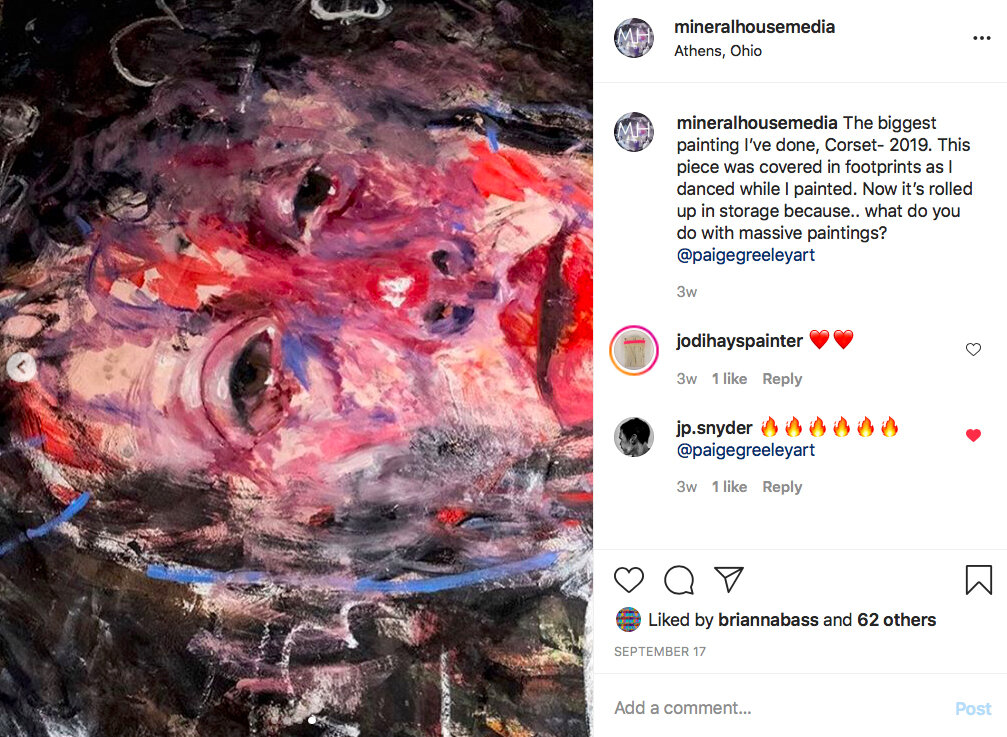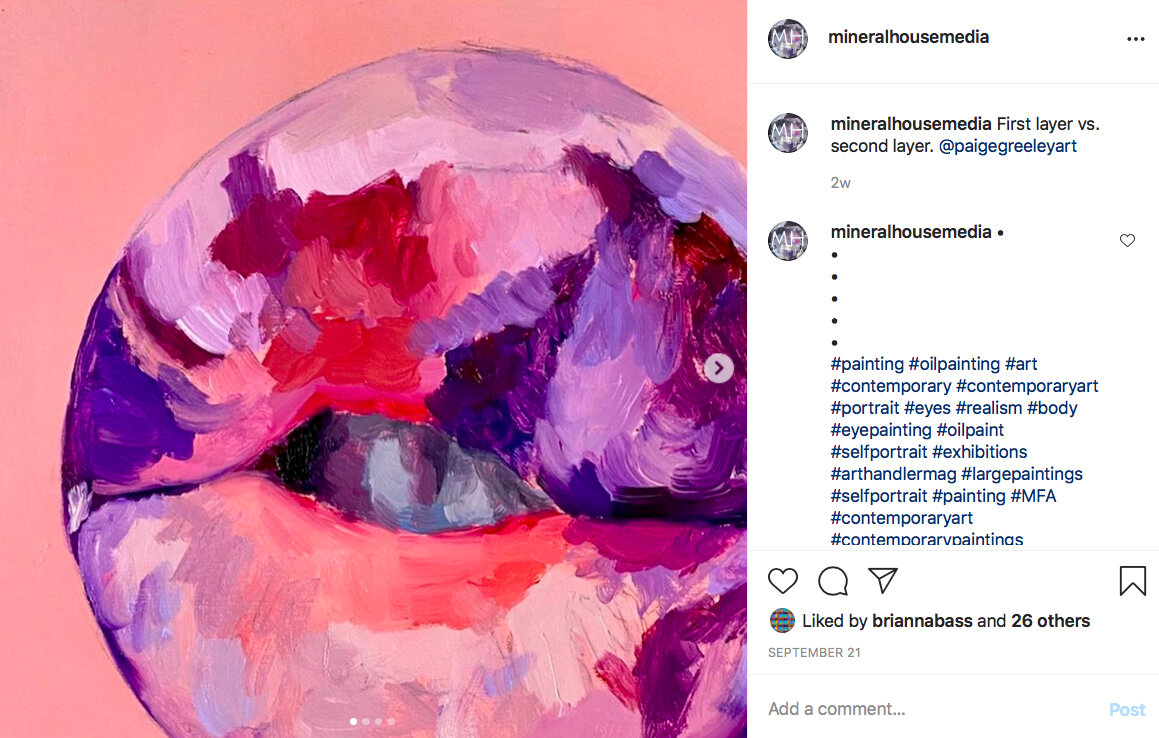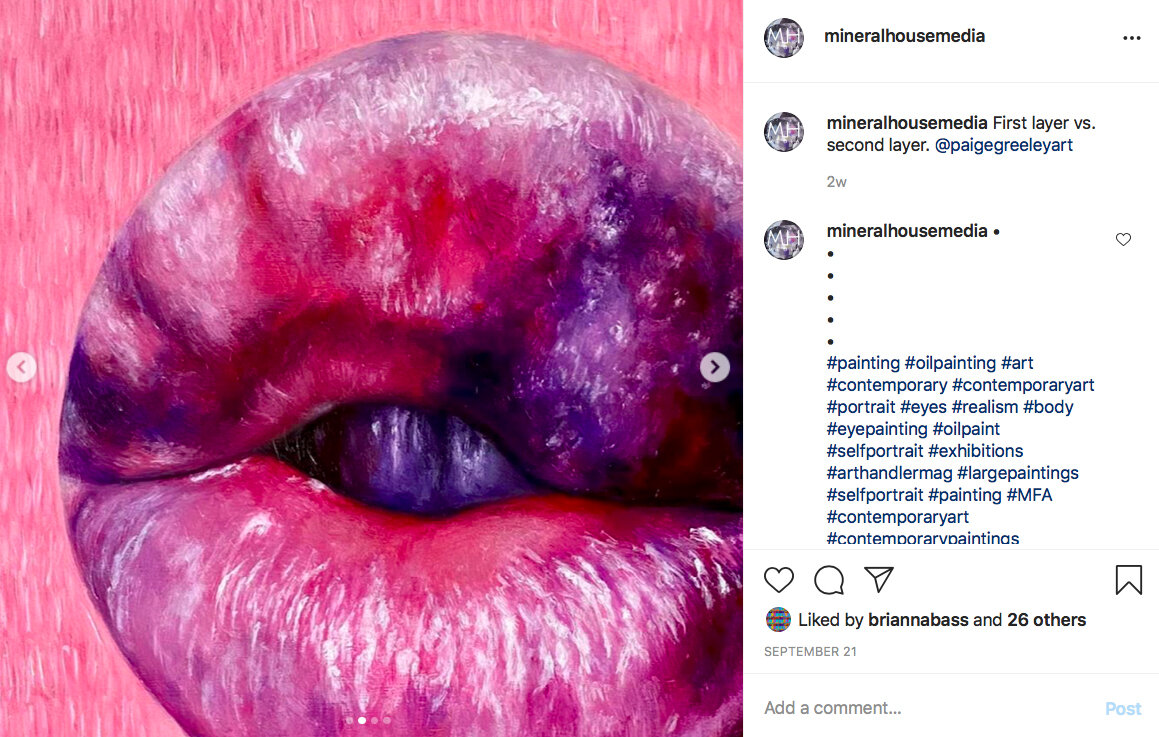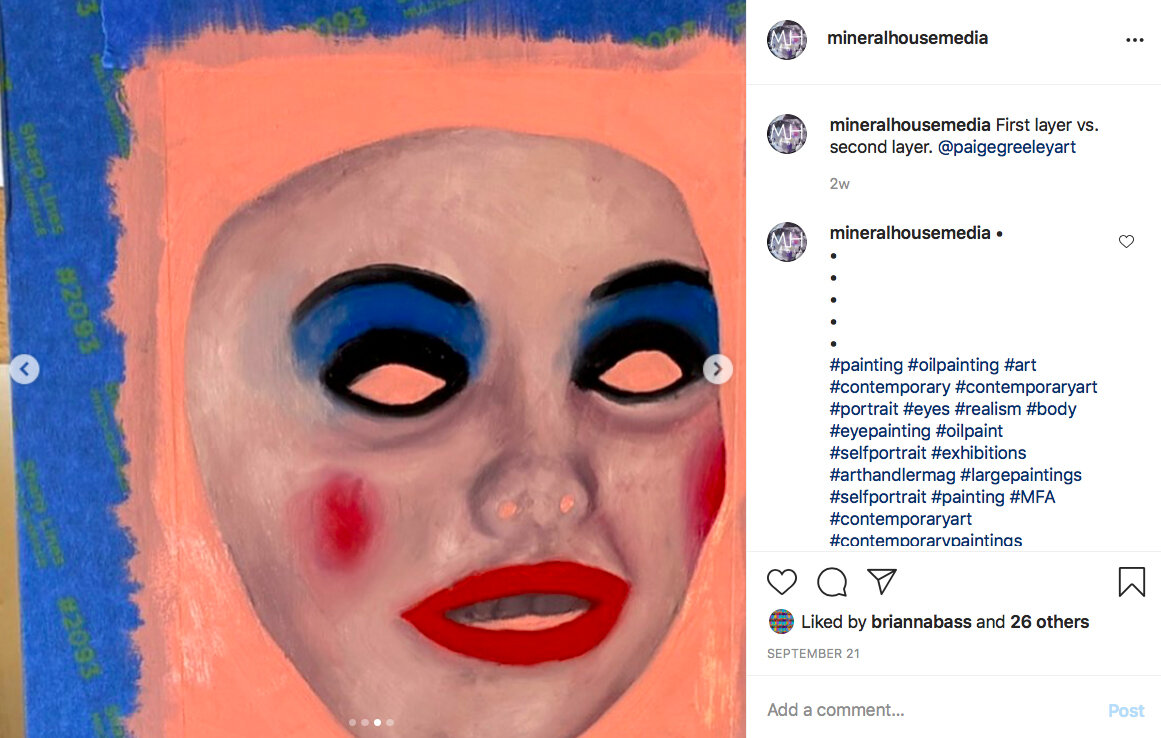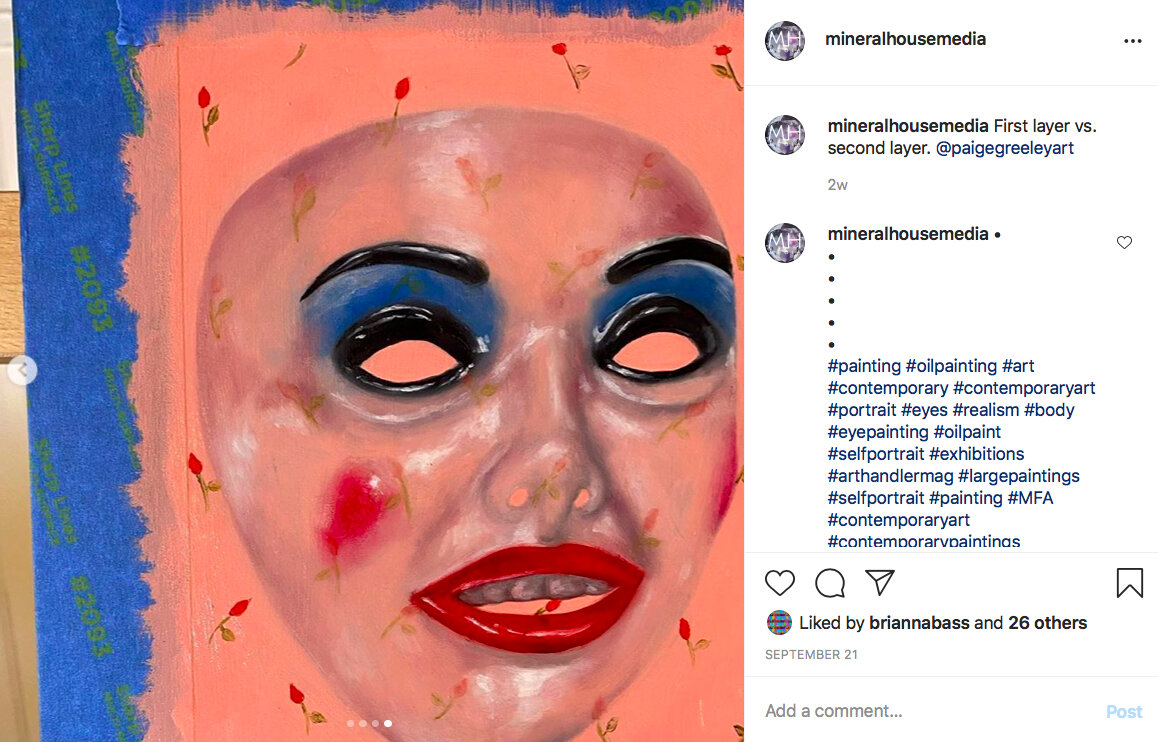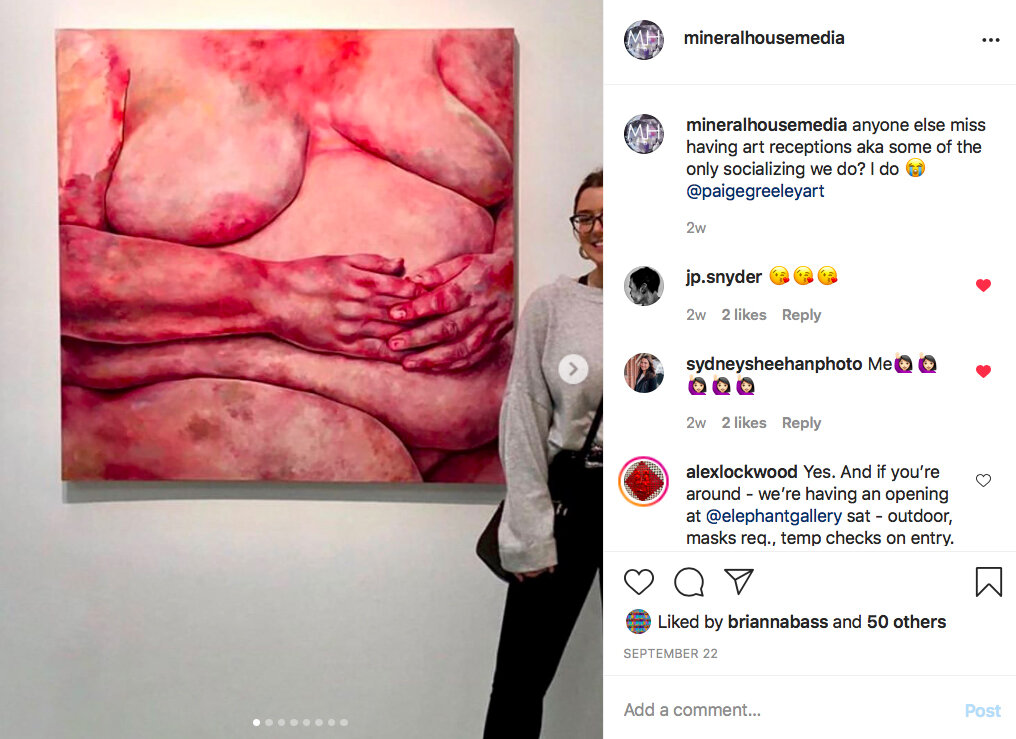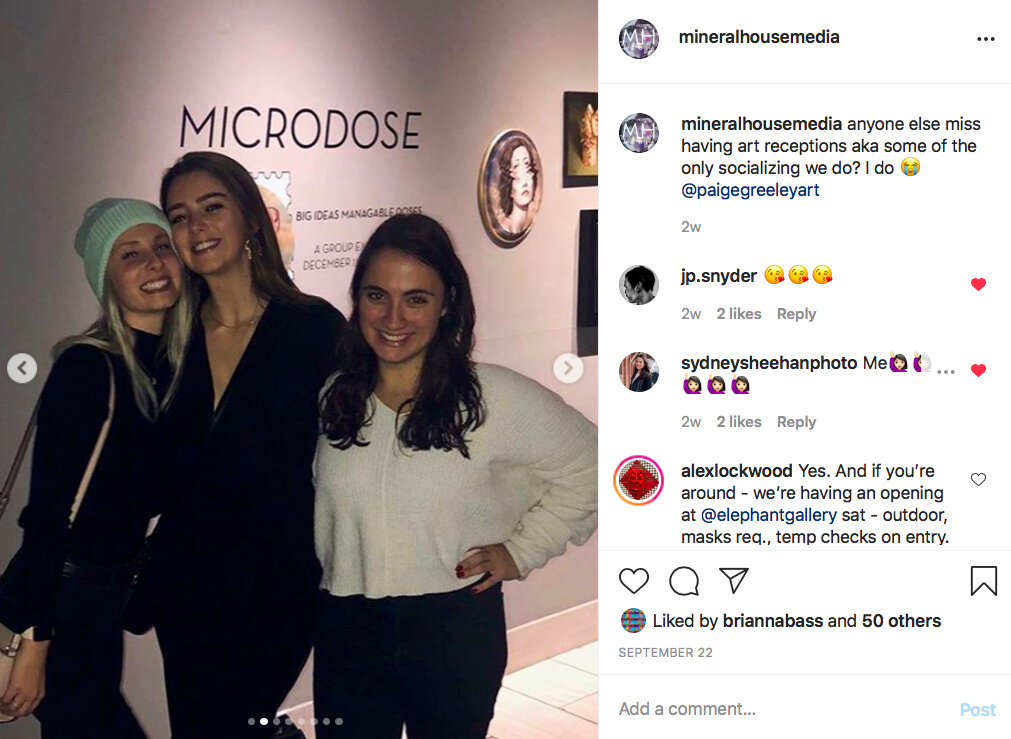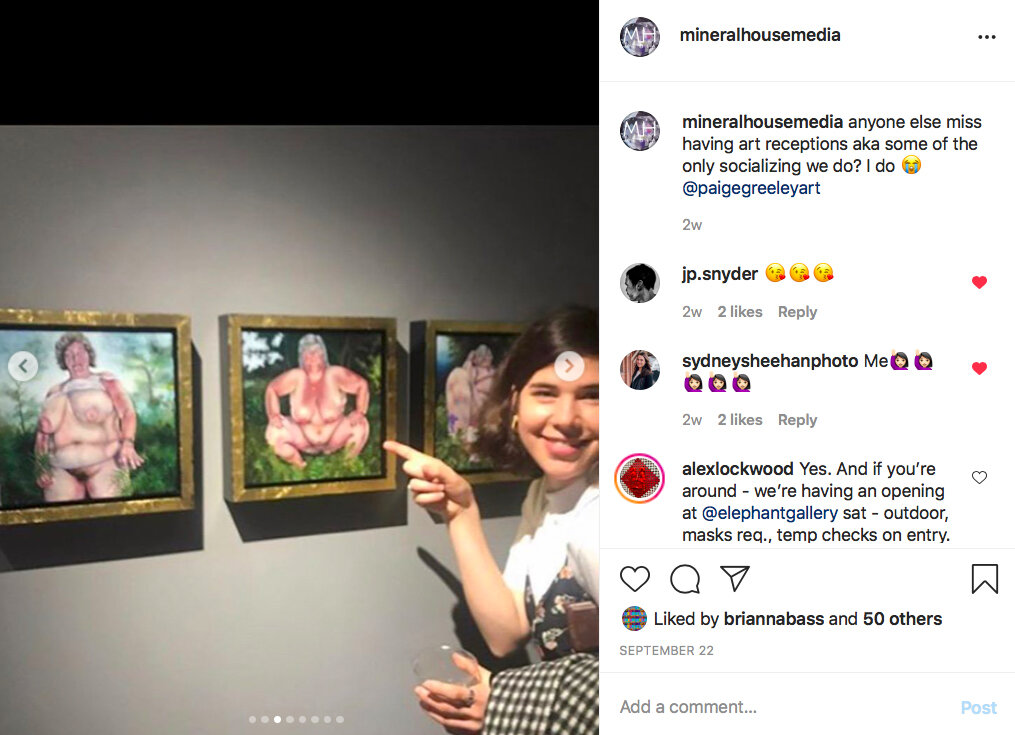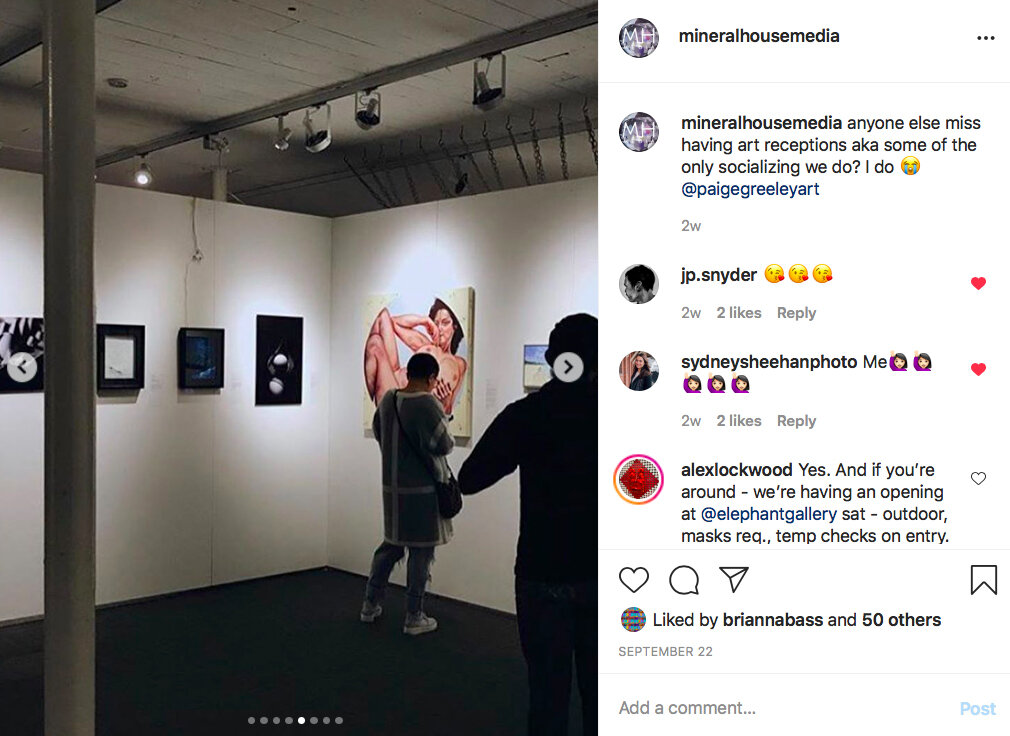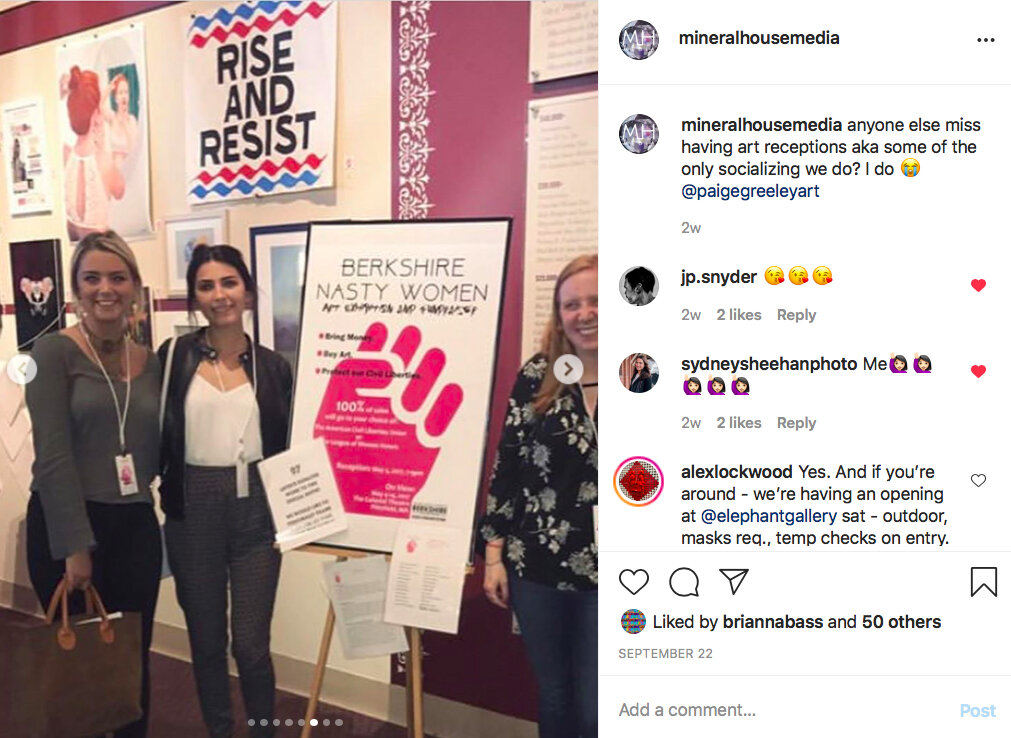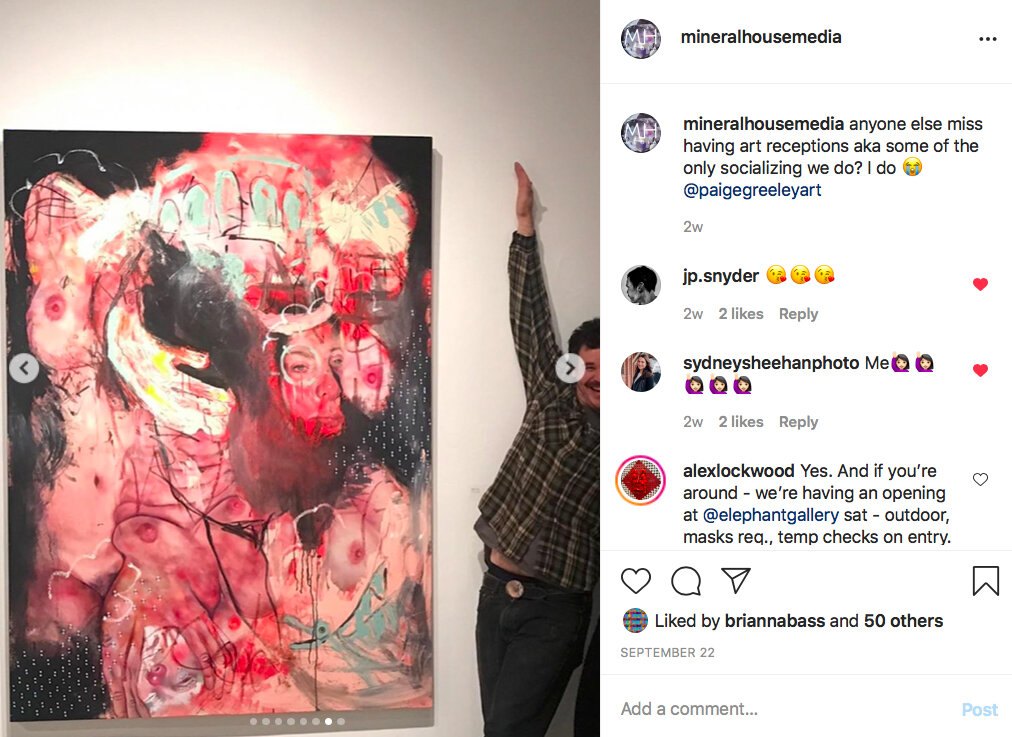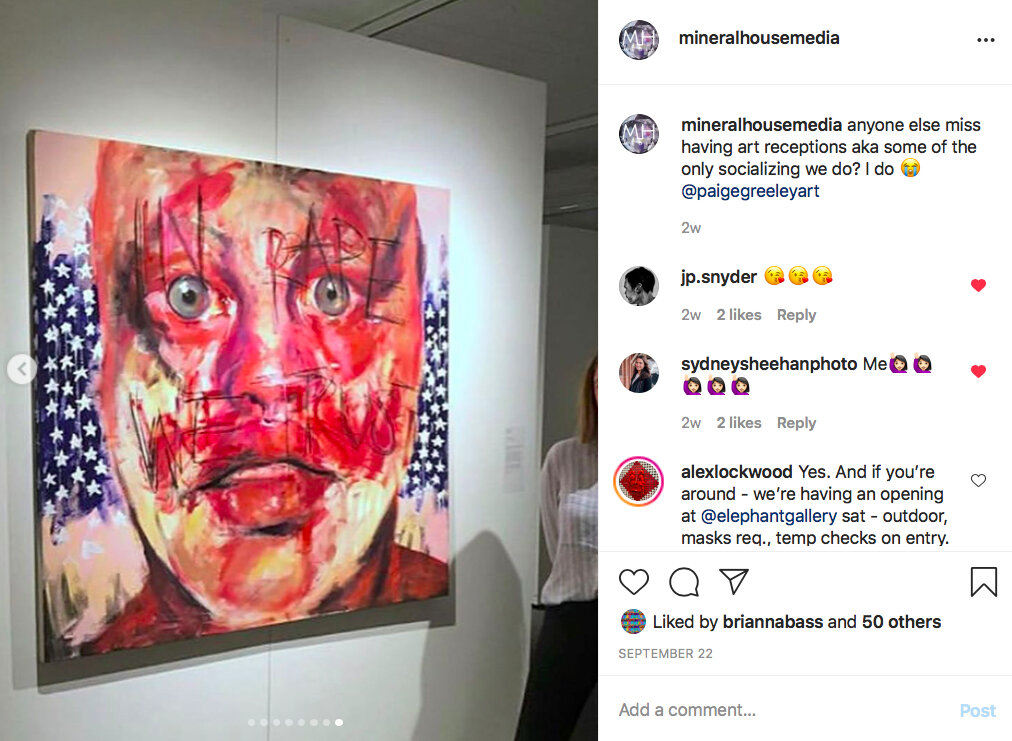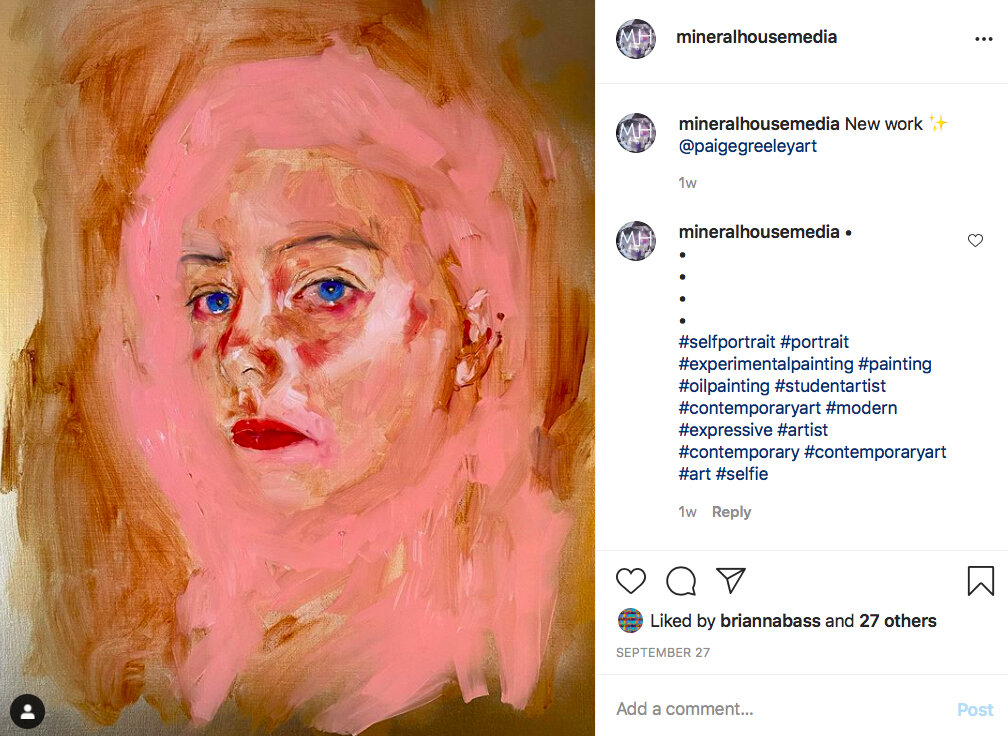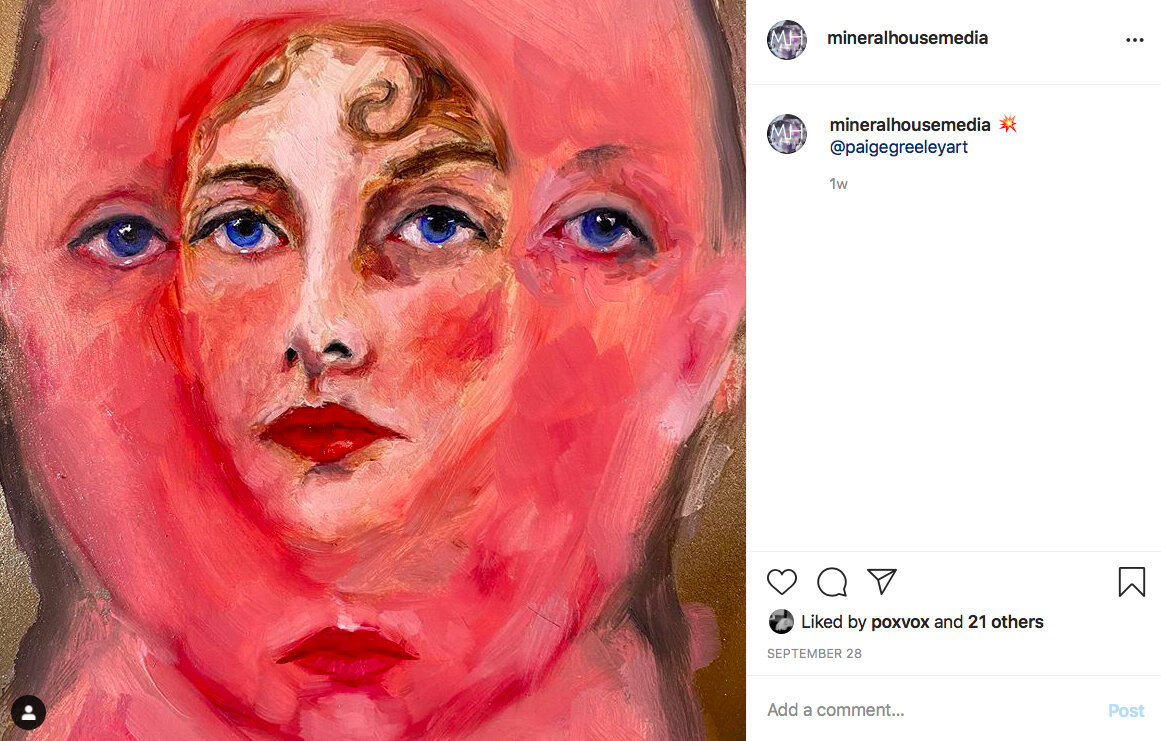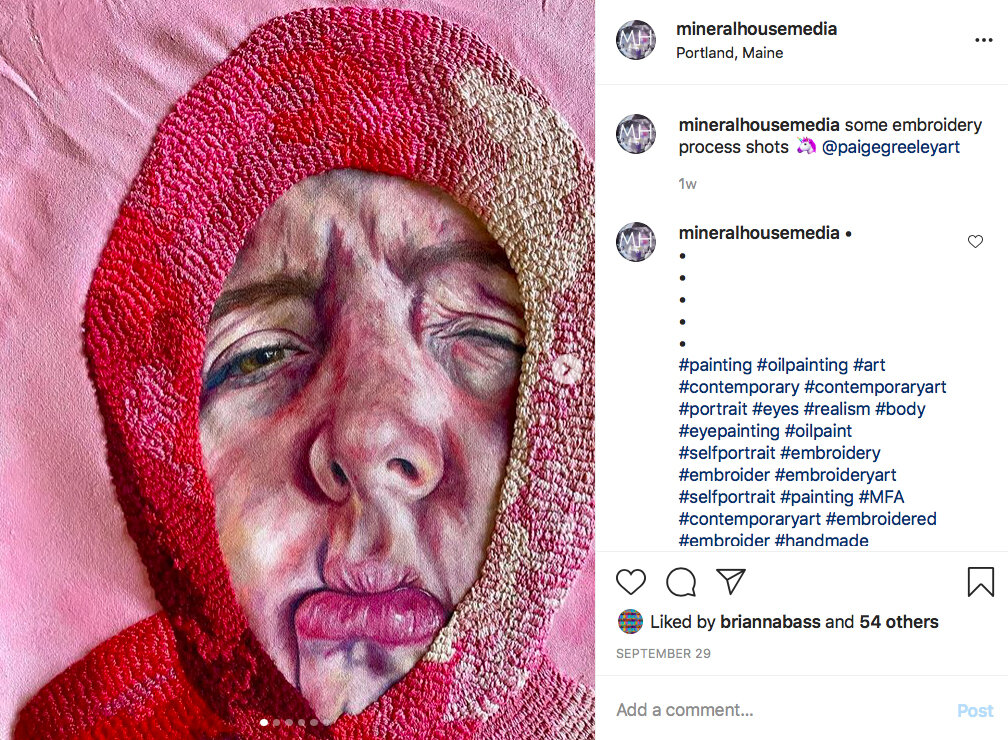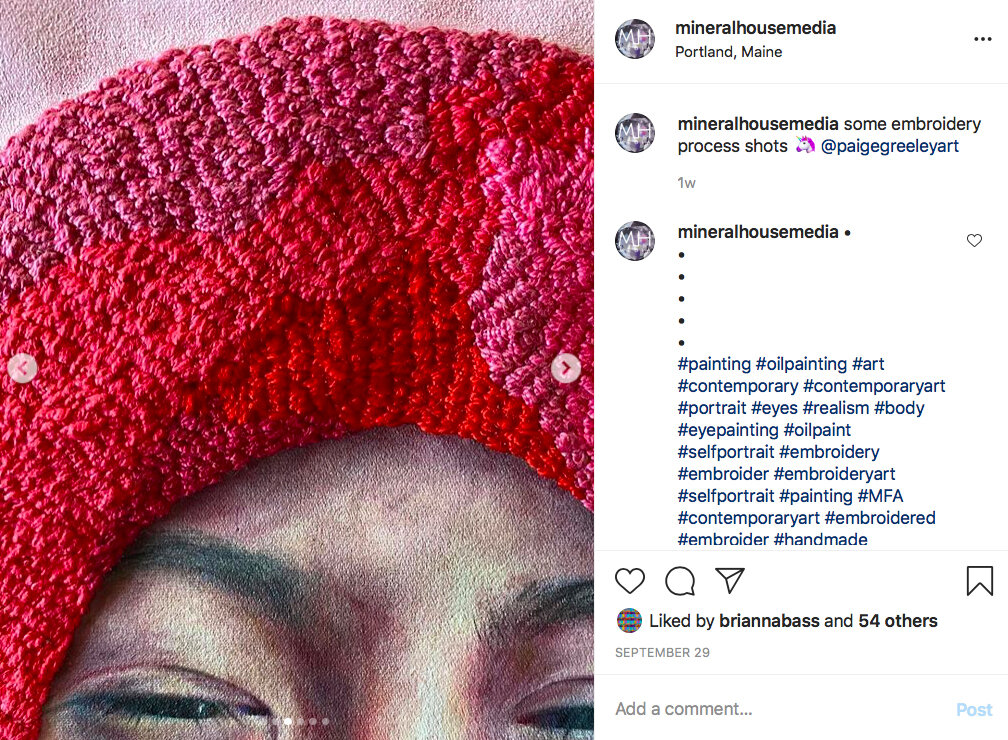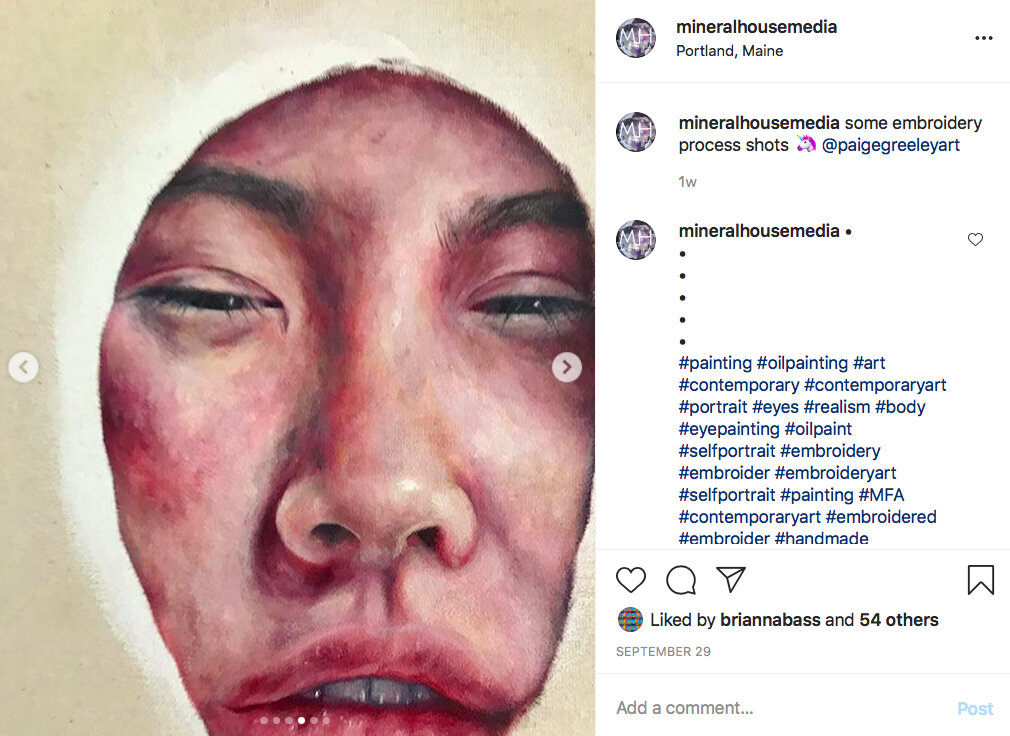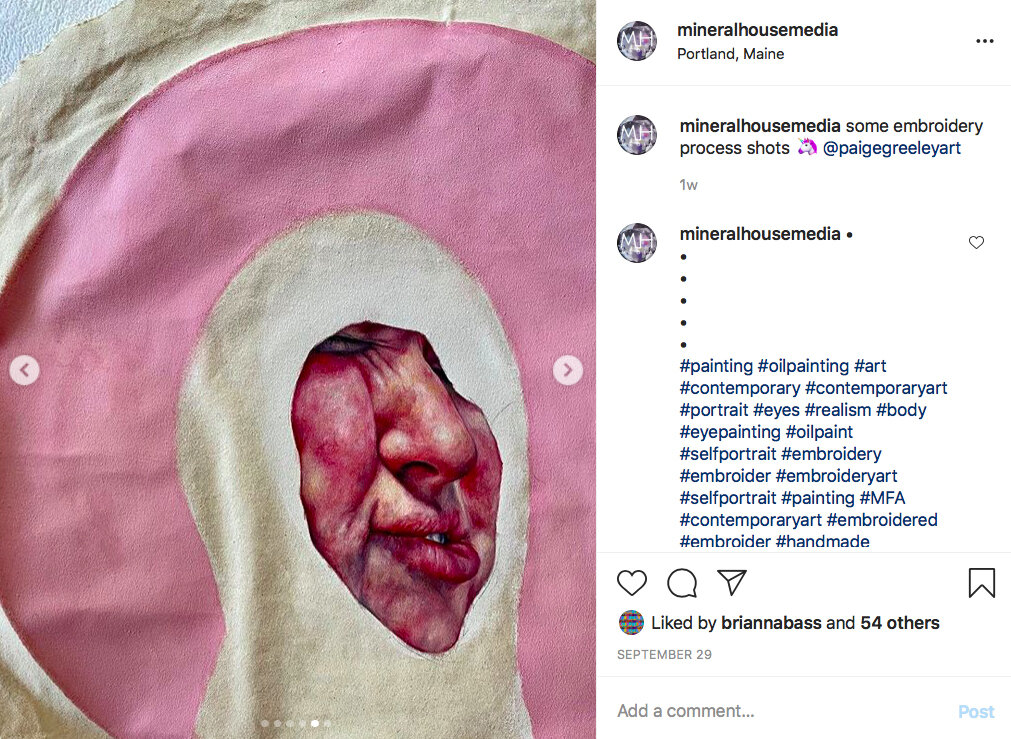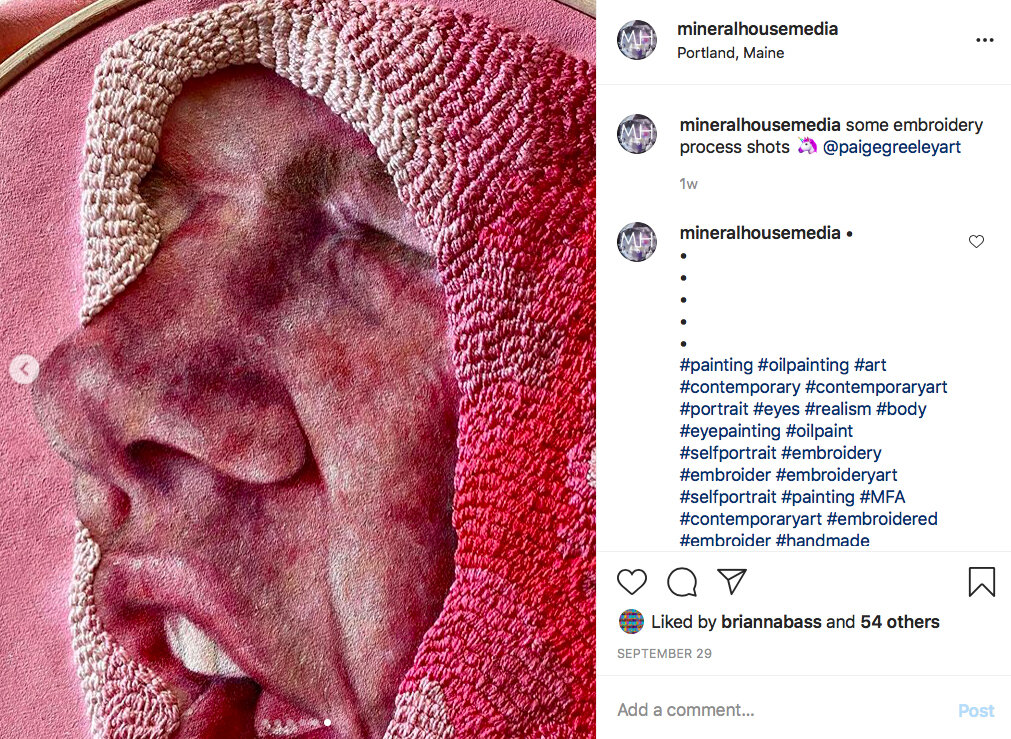Interview with Paige Greeley
Interview with Paige Greeley
SEPTEMBER 2020 DIGITAL RESIDENT
“My current research examines my experience as a Western woman and analyzes my previous adherence to the concept of beauty-as-currency. Feminine beauty is culturally defined and has always been a form of wealth in the West. In my current body of work, I am examining the biological argument for the evolution of this behavior, the overwhelming social pressure to conform to this behavior, subjection by the patriarchy, women’s complicity, and the many forms of exchange involved in utilizing beauty currency. Combining my advocacy work on a rape crisis hotline and my own exploitation, I create visceral, figurative, large-scale oil paintings that examine the perennial dangers of beauty-as-currency and the abuse it inflicts on women.”
-Paige Greeley
Mineral House Media: You describe priming one of your favorite paintings (Night in July) by covering your body in red paint and rolling over the canvas repeatedly. What motivated you, and what do you feel was gained in this act?
Paige Greeley: I doubt I will ever cover my naked body in red house paint and roll on a canvas again, however it still was an experience. I wanted to create a connection between physical body and painted body, to show the hand of the artist per se. It was a metaphorical gesture but was lost within the painting. Experiments working or failing are just a part of the process as an artist and you just have to roll with it. This piece is one of my favorites because it was filled with so many intuitive gestures that came together to work in harmony, a reflection of my emotional being at the time. I really appriciate that.
MHM: Exaggerated reds vibrate throughout many of your compositions. What is the significance of red technically or conceptually for you?
PG: Red is the universal experience of what it is to be in a human body—it is us inside out. Red is the most important color to be represented within my figurative works in order to empathize and connect with others.
Paige Greeley, Night in July.
MHM: Some faces in your paintings display an overt nod to clown makeup, with shiny red noses and whitened skin. What is your intention in adding these elements? What do they mean for the female nude specifically?
PG: In my earlier years of graduate school, I decided that the red nose would be my ‘signature’. I wanted to have something consistent within my scattered ideation of work. The red nose acts as a symbol for post-trauma. Eyes are wiped after crying but the nose remains red—at least for a little while. The women in my work can sometimes be smiling or looking unbothered accompanied with a large red nose. This is an indication of everlasting trauma that sticks to the body like glue. As we know, the female nude has be sexualized and objectified throughout history. In Western Culture, we are now empowered, liberated, but it is important that we do not forget how hard it was to get here, and still is for many women.
MHM: In Night in July, hurried inscriptions echo the body (teeth, a circle around the eye), and patterns float above the planes of the image. What do these gestures do for you as a painter, and for the painting?
PG: I was inspired to paint Night in July after learning about safety houses set up by nuns, sometimes secretly, for battered and abused women and children. These spaces in churches acted as some of the first shelters that women and children would have the opportunity to go to and be safe in. I wanted to tie in symbols of these places within a contemporary rape culture context. This includes a facade of a church, ambiguous with human teeth, angels surrounding the edges of the canvas, and clouds inspired by frescos in the churches. I have scattered contemporary symbols of rape culture such as a hospital gown pattern, drugged figures, and sexualized body parts. The circled eye becomes the focal point of the painting- a confrontation to the viewer. I wanted my viewers to be uncomfortable while looking at this piece due to the historical and contemporary weight it possesses.
MHM: How do you think the scale of the painted body affects the observer's relationship with a painting? What considerations go into planning the scale of your paintings?
PG: I like to paint large and small and finding a balance can be difficult. When I paint on a large scale, 10 x 18 feet lets say, I use my whole body to paint. The act of painting becomes a bodily gesture and I enjoy the mentaphor behind that. In a contrasting light, I can also feel a disconnect to a large piece due to the size itself. It is so much bigger than me, I cannot possibly conquer it, only attempt to.
With my smaller works, I find there is an intimacy. The viewer gets so close to each work, swallowing the small details and desperately looking for more. As the artist, I can wrap the painting in tiny details and hold the painting in my hands. Another plus side is that small pieces are a lot easier to throw away if it doesn’t work out, to be honest.
MHM: It seems like place and narrative are often withheld from your paintings, favoring the physical gesture and forms of the body. Can you address these decisions?
PG: In my work, I often leave out a space but rather focus on the etherial nature of the form to tell the story. In my latest works, such as Ameliorate, I am experimenting with putting my figures into domestic space to better tell a narrative. I believe that my older work existed in an absence of space but now I am willing to explore how it can add to my concept.
Paige Greeley, Work in Progress.
MHM: There is a sensory parallel between your detailed figure painting and the meticulous process of your embroidery, yet the practices are very different. Does embroidery achieve something (visually or for you personally) that painting does not?
PG: Embroidery is a way to represent time and labor. It is a reflection of the time and labor I have spent on beauty rituals. As a western woman, these beauty rituals are expected of me. I am expected to be beautiful. Not only this, but I am expected to be naturally beautiful, without effort. The effort behind attempting to look effortlessly beautiful is immense. I have spent hours in the salon bleaching, tweezing, waxing, dying, not to mention the cost of it all. I can embroider about 5 stitches in one minute, so when a piece contains thousands of stitches, the time and labor become indisputable. There is also a connection between embroidery being considered womens work in the past and now beauty labor is the new womens work. Embroidery and Beauty Labor work hand in hand.
MHM: In your embroidered portraits, subjects’ expressions often display strained or compressed features. What do these expressions convey to you in the painting process followed by encasing them in their ‘body suits?’
PG: As I was researching Beauty as Currency in Western Culture, I thought of the idea of the body existing as an external suit- one we are forced to wear and maintain throughout our daily lives. In society, this body suit acts as a direct representation of who we are, despite the major disconnect from soul to physical self. The body says little about who we actually are, but in western culture, it represents us entirely. I wanted to push this idea in my pieces by embroidering body suits around portraits. The suits are suffocating, almost encapsulating the figure. These works properly reflect on my experience as a western woman and comment heavily on the demand to be beautiful, to maintain beauty standards, and to remain beautiful throughout your existence.
MHM: What attracts you to your favorite color, pink? In what ways have you found yourself surrounded by this color?
PG: Pink is the color of little girls, everything cute and sweet, and also a physical weakness, the color that is is stamped onto women with no consent, binary. We have skewed Pink to trap and shame little girls, to remind them of their position in society below men. I aim to reclaim the color Pink in my work. I want it to be a representation of empowerment and reimagine it as feminine power- unstoppable power. It is encapsulating, inspiring, nauseating, angry, a reclamation.
Paige Greeley, Ameliorate.
MHM: Has your vision of these works changed over time? If so, how do these changes communicate with your ongoing practice?
PG: When I entered graduate school I was, and still am, very passionate about rape culture in the western world. After two years of my work being absorbed within this concept, I wanted to narrow it down and speak from my own experience. This is when I heard a quote from photographer Lauren Greenfield, “Girls learn from a young age that they can use their bodies as currency”. Suddenly, everything clicked and I realized that had been me, and was still me. I lived my life, up until recently, thinking that beauty was my most valuable social currency. My work began to be about beauty as currency and is still very much influenced by my research on rape culture in the western world.
MHM: What are your favorite aspects of showing work in gallery settings versus digital space? What do you look forward to returning to or integrating in new ways for traditional shows?
PG: I love the accessibility of online exhibitions as an artist and a viewer. A city show suddenly becomes a global exhibition. In the age of technology and social media, this is critical. With the wonderful benefits online shows bring us, so much is lost. Seeing the work in person is often much different than viewing it on a phone or computer screen. This is especially true for three dimensional art works. Personal interaction is also lost and for many artists, receptions are some of the only socializing we do. The genuine excitement of an opening reception can not be actualized in an online space. Moving forward, I hope we combine the benefits of both digital and traditional shows by creating accessible, online spaces for every in-person exhibition.
Paige Greeley received a BFA in Fine Arts from Endicott College and is currently an MFA Painting + Drawing Candidate at Ohio University. She has exhibited her paintings at Booth Gallery in New York City, The Dark Arts Emporium in Long Beach California, Nasty Women Exhibitions throughout the US, the Photographic Resource Center in Boston, a solo show at Local 188 in Portland, and at Ganzo Gallery in Italy.
